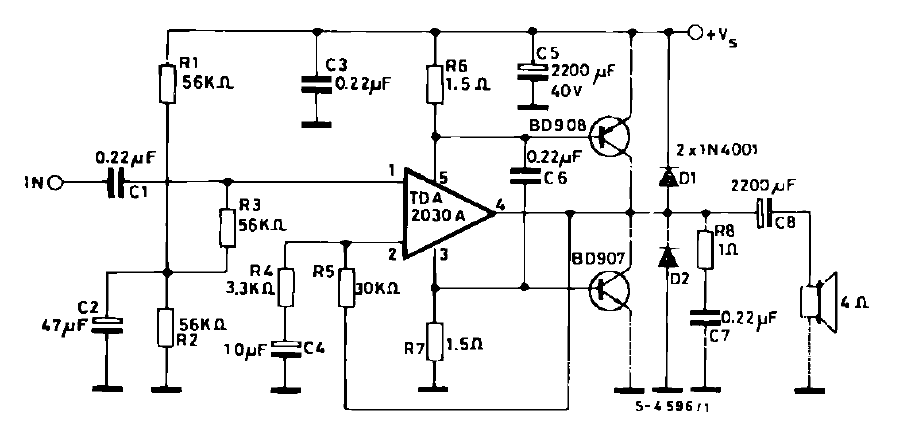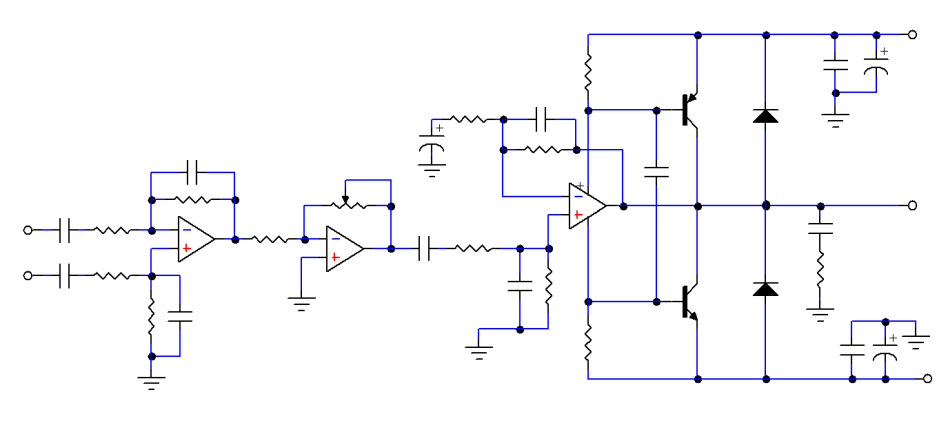|
TDA2030A The TDA2030A has less power when compared to the TDA7293 and the LM3886TF. I believe it is capable of 14W into 4 ohms without clipping. To get more power out of this chip amp, I eventually settled on using additional transistors to support the TDA2030A.
In the schematic above (Fig 1), two transistors are added to the TDA2030A. They operate in Class B most of the time. What this means is that they are basically OFF. When the TDA2030A is unable to supply enough current to the speakers, that’s when these transistors switch on, thus supplementing the TDA2030A current delivery. This happens when driving 4 ohm speakers at higher volumes. Are these additional transistors detrimental to the sound quality? The THD plots from the manufacturer give us an insight.
Fig 2 is the THD vs Power Output of the TDA2030A with the two additional transistors (BD907/908). The measurements are indeed quite impressive. At 1kHz, THD is about 0.02%. At 15kHz, THD is 0.05%. This is clean power of close to 25W into 4 ohms. That’s 10W more than just using the TDA2030A on it’s own. As stated in their datasheet, the TDA2030A is indeed up to HiFi standards. Beyond 25W, the amplifier clips. That’s where we see the THD shooting straight up. Users that complain the TDA2030A sounds harsh is not the fault of the chip amp. It’s due to driving the amplifier into clipping. TDA2030ProWith it’s upgraded power output, I can see potential in commercial applications. Like the TDA7293Pro before it, this TDA2030Pro can be used for HiFi quality Background Music (BGM) in restaurants and fashion boutiques. Houses of worship can use them for broadcast or schools for public announcements.
In this kind of use, it’s essential that the inputs are Balanced. This is achieved by the use of a Dual op amp. After the input balanced amp is the Gain adjustment. The sensitivity of the TDA2030Pro can then be adjusted for dBu or dBV. This is important as the active speakers will be manned by a mixer remotely. Without this adjustment, there’s no way to know how much power is coming out of the amplifier. TDA2030Pro PCB
The TDA2030Pro pcb is very small for a power amplifier. It measures 3.5″ x 2″ only. On it are the TDA2030A chip amp, two medium power transistors, one op amp and two voltage regulators. If that’s not enough, there are even two power supply caps totaling 6600uF and a Bridge Rectifier. It’ll be interesting to see how this TDA2030Pro fares when it’s ready. It’s a shame that this chip amp has been discontinued. This seems to be the trend in audio today. Hopefully, the situation will improve in future. Meanwhile, I have 100 pcs in my inventory. Original SGS Thomson. Not fakes. Time to put them to good use. |

February 22, 2022Electronics, Projects

 Fig 2 – THD vs Output Power
Fig 2 – THD vs Output Power Fig 3 – Schematic of TDA2030Pro
Fig 3 – Schematic of TDA2030Pro